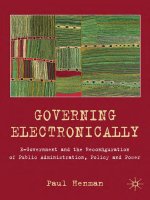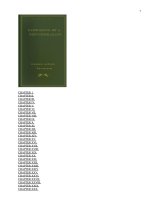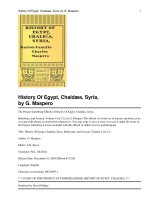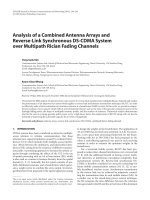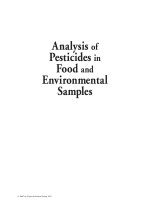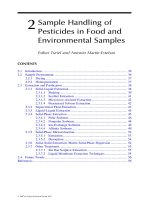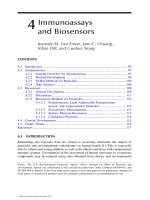Exergoeconomic analysis of a combined water and power plant 4
Bạn đang xem bản rút gọn của tài liệu. Xem và tải ngay bản đầy đủ của tài liệu tại đây (1.91 MB, 110 trang )
Results and Discussion
_____________________________________________________________________
131
CHAPTER-5
RESULTS AND DISCUSSION
In this research project, both experimental and numerical investigations were
conducted to determine the performance characteristics of the system under different
operating conditions. In addition, projections of the systems performance in multi-
effect mode and parametric studies were referred after validation of the simulation
model. This chapter mainly contains the results and discussion of the important
findings. The chapter has been divided in the following sections:
• Validation of simulation results of the combined cycle power plant with
Thermoflow
®
and other published literature.
• Experimental parametric investigations of the MED and RO systems
• Thermal and hydraulic performance comparisons of different tube profiles
• Comparison of experimental and simulation results.
Description of each of the sections is included in the following section.
5.1 Combined cycle power plant simulation results
The major part of the research project is to utilize the waste heat from the combined
cycle power plant at full load. Moreover, to analyze the effect of bleeding steam out
from the power plant at part load condition was considered. In order to do so, a model
combined power plant (Siemens V94.2 Gas turbine series) has been taken whose
operating parameters are given in Table 5.1. A series of simulation runs were carried
out on the system to determine the performance characteristics under different
operating conditions. Commercially available simulation software Thermoflow
®
was
used for the verification of the simulation results. The simulation results follow the
following sequence:
Results and Discussion
_____________________________________________________________________
132
a. Power plant efficiency, steam cycle efficiency based on First law of
thermodynamics comparison with Franco et al. (2002).
b. Gross power output and other important power plant parameters
verification with Thermoflow
®
.
c. Comparison with Rensonnet et al. (2007) for power plant efficiency,
exergetic efficiency and water cost comparison.
Table 5.1 Different input parameters for combined cycle power plant for Siemens
V94.2
Gas Turbine Work Output, W
GT(full-load)
250 MW
Steam Turbine Work Output W
ST(full-load)
115MW
Compressor Inlet temperature, T
1
25
o
C
Compressor Inlet Pressure, P
1
101.3 kPa
Pressure ratio, P
2
/P
1
11.65
Gas Turbine inlet temperature 1076 °C
Gas Turbine exit temperature, T
4
586 °C
Efficiency of gas turbine at design load ,
GT
η
0.89
Efficiency of compressor at design load,
C
η
0.89
Efficiency of steam turbine,
ST
η
0.9
Mass flow rate to the compressor, m
1
513 kg/s
Temperature of flue gas leaving HRSG II, T
6
85
o
C
HRSG I condensate inlet pressure, P
d
60 bars
Temperature of water after exit of HRSG I , T
d
500
o
C
Pressure of bled steam, P
e
3 bar
Pressure at condenser, P
b
0.07 bar
Results and Discussion
_____________________________________________________________________
133
5.1.1 Power plant simulation results
The developed simulation program for the power plant was executed with the data
from Table 5.1 and checked with that of the Franco et al. (2002), as shown in Table
5.2. The simulation program can predict within ±8% of the published results. From
the simulation results, it can be concluded that the program developed can predict the
performance of the power plant fairly well under different conditions.
Table 5.2. First law Power plant efficiencies and comparison with Franco et al. (2002)
5.1.2 Power plant simulation validation with Thermoflow
®
The reliability test of the developed power plant simulation program can be ensured
with the checking of gross power output from gas turbine (GT), steam turbine (ST)
and their efficiencies, respectively.
So, several load conditions were tested with Thermoflow
®
taking the input parameters
same as that of Table 5.1. Table 5.3 compares the gross output power of GT, ST, and
total gross power output of the combined power plant. Lastly thermal efficiency of the
power plant from full load / rated load to 60% of the rated load condition was
checked. From Table 5.3, it shows that if the load is decreased by 20% (from 100% to
80%) the power output reduces by almost 30%. Moreover, the thermal efficiency
decreases drastically if the load is reduced.
Load (%)
Steam cycle efficiency, η
, η, η
, η
ST
Combined cycle efficiency, η
, η, η
, η
cc
Simulation Franco et al. (2002) Simulation
Franco et al. (2002)
100
0.33 0.35 0.49
0.5
80
0.3 0.28 0.45
0.45
70
0.25 0.23 0.4
0.4
60 0.21 0.19 0.35 0.35
Results and Discussion
_____________________________________________________________________
134
Table 5.3. Comparison of results with thermoflow for combined cycle power plant.
5.2 Combined water and power plant simulation results
In the previous section, the thermal efficiency of the combined cycle power plant was
studied. Now, the combined cycle is coupled to the MED plant (CC+MED), and
followed by the RO plant coupled to the combined cycle with the MED plant
(CC+MED+RO). In case of CC+MED+RO plant, then unused electrical load is
imposed onto the power plant to run the RO plant. Now, the imposed electrical load
will depend on the water demand which is met by RO. This electricity consumed by
RO is simulated to be 5%, 10% and 15% of the designed operating load of the
combined power plant. The trend of water production with efficiency for different
configurations of the combined water and power plant is also studied.
Thermoflow
Simulation
Thermoflow
Simulation
Thermoflow
Simulation
Gas turbine
relative
load (%)
100 100 80 80 60 60
Gross
power
output GT
[MW]
285.1 287.2 196.5 198.3 147.4 148.2
Gross
power
output ST
[MW]
144.6 146.1 119.4 121.2 102.1 104.5
Gross
power
output
[MW]
429.6
433.3
316
319.5
249.4
252.7
Net plant
efficiency
[% of LHV
input]
56.3 56.78 41.3 41.76 39.1 39.62
Results and Discussion
_____________________________________________________________________
135
5.2.1 Effect of Combined cycle load on Thermal Efficiency
The trend of efficiency with load is shown in Figure 5.1. It shows that, the combined
cycle power plant has the lowest efficiency among the 3 modes of configurations.
Thermal efficiency of the combined water and power plant increases by about 5%
when the MED plant is coupled to the power plant. In addition, when the RO plant
operates, there is a further increase of about 10%.
Figure 5.1 Variation of thermal efficiency with Combined cycle load
Therefore, the efficiencies of the combined water and power plant will increase with
increasing capacity of the RO plant. The CWPP graphs show more sensitiveness
across the cases rather than on the load itself. These results show tremendous prospect
in terms of savings in the primary energy consumption and output of the CWPP.
In short, the efficiency of the combined water and power plant increase with
increasing capacity of the RO plant. Even when it is just the MED plant that is
coupled to it making use of the thermal energy inherent in the flue gas that is going
Results and Discussion
_____________________________________________________________________
136
out of the heat recovery steam generator of the plant, it has a higher efficiency than
that of a combined cycle power plant alone.
5.2.2 Combined Water and Power Plant (CWPP) result comparison with
Rensonnet et al. (2007)
Water production cost relies heavily on electricity cost, steam cost and above all the
exergetic efficiency of the Combined Water and Power Plant (CWPP). Rensonnet et
al. (2007) studied the different combinations of desalination plants combined with
power plant. In that study, when the plant runs at CC+MED mode, steam is bled from
steam turbine deliberately for producing water, thereby, reducing the electricity
output. It in turn increases the electricity cost. When the plant runs at CC+RO no
steam is bled from the steam turbine. So, the electricity output also increses. The
effect is clearly shown on the exergetic efficiecny. The maximum benefit of this type
of combined water and power plant is gained when the plant runs at CC+MED+RO
mode.
Table 5.4. Comparison of power plant parameters with Rensonnet et al. (2007)
Rensonnet et al. (2007) Simulation Result
CC+MED CC+RO
CC+ME
D
+RO
CC+MED CC+RO
CC+ME
D
+RO
Power of
Gas Turbine
(kW)
70,100 70,100 70,100 70,100 70,100
70,100
Power of
Steam
Turbine
(kW)
29,156 42,130 29,156 29,145 42,220
29,145
Exergetic
Efficiency
48.7 55.19 57.2 49.1 56.7
58.2
Cost of
electricity
(US¢/kWh)
12 9 10 13 10
11
Results and Discussion
_____________________________________________________________________
137
Cost of
distillate
(US$/m
3
)
0.95 0.80 0.60 1.02 0.83 0.63
5.2.3 Effect of Combined cycle load on Water Production
The water production of 1) the combined cycle power plant with the MED plant, and
2) the combined cycle and power plant with the MED and RO (using 5% of the design
capacity of the power plant) are studied.
It is observed from the figure that the water production decreases with increasing
electrical load. This can be explained by the changes in the amount of steam available
when the load changes. When the electrical load decreases, the amount of steam
available either to produce water through MED or produce electricity is increased as
the amount of steam that is bled will also increase. Therefore, more steam can be sent
to the MED plant for the production of distillate. Hence water production will
decrease with electrical load.
Figure 5.2 Variation of Water Production with Combined cycle load
Naturally, with RO being added on to the combined power and water plant, the water
production will increase. Through the simulation, it is found that the RO plant will
Results and Discussion
_____________________________________________________________________
138
produce 4.54 MIGD of water. Hence, the curve for CC+MED+RO (5%) is shifted by
4.54 MIGD upwards relative to that of CC+MED. And for another 5% increase of
load to power the RO, an additional 4.54 MIGD of water can be produced.
5.2.4 Electricity cost variation with Oil Price
The electricity cost is directly proportional to the cost of oil per barrel for the power
plant. From Figure 5.3, when the cost of the barrel increases, the electricity cost also
increases. The cost of the fuel influences the cost of running the combined water and
power plant directly. Since electricity is the product of the plant, according to the cost
balancing equation, a higher fuel cost will, therefore, equate to a higher electricity
cost.
Figure 5.3 Electricity cost trend with varying barrel cost
0.06
0.07
0.08
0.09
0.1
0.1
1
0.1
2
0.13
0.1
4
0.15
0.16
50
55
60
65
70
75
80
85
90
Barrel Cost (U
S$/bbl)
Electricity Cost (US$/kWh)
Results and Discussion
_____________________________________________________________________
139
Figure 5.4 Exergetic efficiencyof power plants for different electrical loads
From Figure 5.4, as the load increases, the exergetic efficiency of the combined cycle
power plant also increases in a parabolic curve. During part load condition, the
efficiency of the turbine and the compressor decreases. As a result, lesser amount of
electricity is produced during the process, therefore, the lower exergetic efficiency of
the power plant. Another interesting point is as the load increases the rate of
improving exergetic efficiency also decreases.
5.3 Experimental Results of MED
A series of experiments were carried out on the system to determine the performance
characteristics under different operating conditions. The variables considered in this
study are as follows:
• Heating medium flow rate
• Heating medium temperature
• Feed flow rate
• Feed temperature and flashing.
• Top brine temperature.
0.39
0.40
0.41
0.42
0.43
0.44
0.45
0.46
0.47
60 65
70
75
80
85
90
95
100
Load (%)
Exergetic efficiency
Results and Discussion
_____________________________________________________________________
140
The impacts of these operating variables have been analyzed in this section in terms
of the following parameters.
1. Vapour production
2. Performance ratio.
3. Overall heat transfer coefficient.
4. Concentration factor.
5. Specific heat transfer area.
6. Flashing efficiency
7. Fraction of equilibrium.
Detail results for the different tube materials are shown in tabular form in appendix E.
5.3.1 Effect of Heating Medium Flow Rate
Hot water was used as the heating medium (HM) in the shell side of the evaporator.
The thermal performance of the desalination system was investigated with hot water
flow rate ranging from 1.5 m
3
/hr to 3.5 m
3
/hr. The feed concentration was in average
30,000 ppm. From Figure 5.5, it is clearly evident that the increase of hot water flow
rate enhances the thermal performance of the desalination system with the increase in
performance ratio and decrease in the specific heat transfer area for each of the tube-
bundle. For corrugated Cu-Ni (90-10) tube bundle, the performance ratio increases
from 0.75 to 0.914 due to increased vapour production rate which is most significant
compared to other tube-bundles. In MED or MSF, the increase of heating steam flow
rate increase the production but it leads to decrease in performance ratio as energy
input increases, El-Dessouky (1998). Specific heat transfer area found to decrease by
40%, 60%, 37% and 35% for Single-fluted Al, Smooth Cu-Ni, Corrugated Cu-Ni and
PTFE-Coated tube, respectively, when the HM flow rate was changed from 1.5 to 3.5
Results and Discussion
_____________________________________________________________________
141
m
3
/hr. The fresh water production rate for different tube-bundles is shown in Figure
5.6. Increase of heating medium flow rate increases the shell-side heat transfer co-
efficient and eventually the available heat flux for the incoming feed which in turns
improves system’s thermal performance.
0.1
0.2
0.3
0.4
0.5
0.6
0.7
0.8
0.9
1
1.5 2 2.5 3 3.5 4
Heating Medium Flow rate (m
3
/hr)
Performance Ratio
0
200
400
600
800
1000
1200
1400
1600
Specific Heat Transfer Area
(m
2
/kgs
-1
)
Single Fluted Al Smooth Cu-Ni
Corrugated Cu-Ni PTFE Coated Al
Figure 5.5 Variation of performance ratio and specific heat transfer area with
heating medium flow rate (Feed flow: 0.25 m
3
/hr, Feed temp. ~30
0
C, HM
temp.: 55
0
C, Feed concentration: 30,000 ppm)
Performance
ratio
Specific heat transfer area
Results and Discussion
_____________________________________________________________________
142
0
5
10
15
20
25
30
35
1.5 2 2.5 3 3.5 4
Heating medium flow rate (m
3
/hr)
Fresh Water Production Rate (kg/hr)
Single-fluted Al
Smooth Cu-Ni
Corrugated Cu-Ni
PTFE Coated Al
Figure 5.6 Variation of fresh water production rate (kg/hr) with heating
medium flow rate (Feed flow: 0.25 m
3
/hr, Feed temp. ~30
0
C, HM temp.: 55
0
C
and Feed concentration: 30,000 ppm)
The specific heat transfer area for each of the tube-bundles decreases with the
increase in hot water flow rate, as shown in Figure 5.5, which improves the economy
of the desalination system with a fixed heat input. The specific heat transfer area is the
maximum for PTFE-coated smooth Aluminum tube-bundle due to less production of
vapour with the same heat transfer area as compared to other tube-profiles. The result
resembles with the study made by Dessouky et al. (1999), where performance of
plastic heat exchanger made of PTFE was evaluated. An increase of 2 to 4 times more
heat transfer area than metal exchanger was found there whereas in the present study
it is found to be 1.2 times as only coating is applied to the metal surface instead of
plastic heat exchanger. So, if the coating durability proves to be efficient through
proper investigations after a long period of operation, PTFE coated metal tube may be
a good option for reducing the scale formation.
Results and Discussion
_____________________________________________________________________
143
Figure 5.7 shows the improvement of overall heat transfer co-efficient due to heating
medium flow rate variation.
0
200
400
600
800
1000
1200
1400
1.5 2 2.5 3 3.5 4
Heating Medium Flow Rate (m
3
/hr)
Overall Heat Transfer Co-efficient (W/m
2
K)
Single-fluted Al
Smooth Cu-Ni
Corrugated Cu-Ni
PTFE coated Al
Figure 5.7 Variation of Overall heat transfer coefficient with heating medium flow
rate (Feed flow: 0.25 m
3
/hr, Feed temp. ~30
0
C, HM temp.: 55
0
C and Feed
concentration: 30,000 ppm)
The increased heating medium flow rate increases Reynolds number and,
consequently, shell-side heat transfer co-efficient leading to an improvement of the
overall heat transfer coefficient. The average salt concentration in product water was
24-32 ppm, which is fairly below the standard set by WHO (500 ppm) for potable
water. Average uncertainty in fresh water production was found to be about 1.9%,
while that for experimental overall heat transfer coefficient was 12%.
5.3.2 Effect of Heating Medium Temperature
The temperatures of the hot water were varied between 47 and 65
0
C with a heating
medium flow rate of 3.5 m
3
/hr. From Figure 5.8, it is evident that with the increase of
∆T
H
, i.e. the difference between the temperature of hot water and saturation
temperature of the evaporator, the vapour production increased almost linearly.
Results and Discussion
_____________________________________________________________________
144
0
10
20
30
40
50
60
5 10 15 20 25
∆T
H
(
0
C)
Vapour Production (Kg/hr)
Single-fluted Al
Smooth Cu-Ni
Corrugated Cu-Ni
PTFE-Coated Al
Figure 5.8 Variation of fresh water production rate (kg/hr) with heating
medium temperature (Feed flow: 0.25 m
3
/hr, Feed temp. ~30
0
C, HM flow
rate: 3.5 m
3
/hr and Feed concentration: 30,000 ppm)
The increase was found to be more prominent for each of the tube-bundle with
different tube-profile, when ∆T
H
was more than 15
0
C. As the heating medium
temperature was increased, the heat flux to the feed water increased as well. The
vapour production starts at an earlier in the tube because of the higher heat flux. Tube
side heat transfer co-efficient increases because of the increased quality and heat flux.
For the corrugated tube, an increase in hot water temperature from 47
0
C to 65
0
C,
increased the production from 7.312 to 55.56 kg/hr. Corrugated Cu-Ni (90-10) tube
exhibits higher performance compared to other tube profiles.
Figure 5.9 shows the concentration factor, X
b
/X
f
, increases with the increase of
heating medium temperature. This can be attributed to the higher vapour production
rate, which increases the concentration of the blow down brine solution. The
concentration factor increases from 1.03 to 1.29 with the increase of ∆T
H
from 5.5
0
C
to 23.5
0
C for corrugated Cu-Ni tube-bundle due to increased production. In MED or
Results and Discussion
_____________________________________________________________________
145
MSF, blow down concentration ratio normally lies between 1.7-1.8 reported by Wu
(2003).
1
1.05
1.1
1.15
1.2
1.25
1.3
1.35
5 10 15 20 25
∆T
H
(
0
C)
Concentration factor (X
b
/X
f)
Single-fluted Al
Smooth Cu-Ni
Corrugated Cu-Ni
PTFE-Coated Al
Figure 5.9 Variation of concentration factor with heating medium temperature
(Feed flow: 0.25 m
3
/hr, Feed temp. ~30
0
C, HM flow rate: 3.5 m
3
/hr and Feed
concentration: 30,000 ppm)
The concentration factor is minimum for PTFE-Coated Al tube due to its slightly
lower production compared to the other tube profiles.
Figure 5.10 shows the increase in fraction of equilibrium (β) with the increase of
heating medium temperature which improves the thermal performance of the system.
With the increase of β, the feed temperature quickly approaches the saturation
temperature corresponding to the evaporator pressure.
Results and Discussion
_____________________________________________________________________
146
0
0.1
0.2
0.3
0.4
0.5
0.6
0.7
0.8
0.9
1
5 10 15 20 25
∆T
H
(
0
C)
Fraction of Equilibrium,
β
Single-fluted Al
Smooth Cu-Ni
Corrugated Cu-Ni
PTFE-Coated Al
Figure 5.10 Variation of fraction of equilibrium with the heating medium
temperature (Feed flow: 0.25 m
3
/hr, Feed temp. ~30
0
C, HM flow rate: 3.5
m
3
/hr and Feed concentration: 30,000 ppm)
5.3.3 Effect of Feed Flow Rate
The effect of feed water flow rate on the performance of the system was investigated
for flow rates ranging from 0.21 m
3
/hr to 0.75 m
3
/hr. The concentration of the feed
brine solution was 30,000 in average. Figure 5.11 shows that with the increase of feed
flow rate, the performance ratio decreases.
The uncertainty in fresh water production is within 2.5-3.1% and for fraction of
equilibrium, it is 5-8.2%, as calculated from the standard deviation of the measured
temperature.
Results and Discussion
_____________________________________________________________________
147
0
0.1
0.2
0.3
0.4
0.5
0.6
0.7
0.8
0.9
0.21 0.31 0.41 0.51 0.61 0.71 0.81
Feed flow rate (m
3
/hr)
Performance ratio (PR)
Single-fluted Al
Smooth Cu-Ni
Corrugated Cu-Ni
PTFE-Coated Al
Figure 5.11 Variation of performance ratio with feed flow rate (HM flow: 2.5
m
3
/hr, Feed temp. ~30
0
C, HM temp.: 55
0
C and Feed concentration: 30,000
ppm).
With the increase of feed flow rate, the fluid velocity increases which reduces the
residence time. Consequently, it allows less time for the fluid to attain thermal
equilibrium. As seen from Figure 5.12, the fraction of equilibrium decreases with the
increase of feed flow rate. As a result, the vapour production decreases which
decreases the performance ratio as shown in Figure 5.11.
In the study made by Darwish et al. (1976), it was also found that an increase of the
feed flow rate in a flashing chamber decreases the efficiency of the flash chamber.
With the increase of feed flow rate for each of the tube-bundle, the concentration
factor decreases while the specific heat transfer area increases, as seen from Figure
5.13. The implication of this result is that increasing feed flow rate to get higher yield
of fresh water production needs higher heat transfer area. For the present study, an
increase in feed flow rate from 0.21 to 0.75 m
3
/hr, increases the required heat transfer
Results and Discussion
_____________________________________________________________________
148
area for single-fluted Aluminum tube profile by 35% to get the production at
0.21m
3
/hr with the same heat input.
0.6
0.65
0.7
0.75
0.8
0.85
0.9
0.95
0.2 0.3 0.4 0.5 0.6 0.7 0.8
Feed flow rate (m
3
/hr)
Fraction of equilibrium,
β
Single fluted Al
Smooth Cu-Ni
Corrugated Cu-Ni
PTFE-Coated Al
Figure 5.12 Variation of fraction of equilibrium with feed flow rate (HM
flow: 2.5 m
3
/hr, Feed temp. ~30
0
C, HM temp.: 55
0
C and Feed concentration:
30,000 ppm)
0
500
1000
1500
2000
2500
3000
0 0.2 0.4 0.6 0.8
Feed flow rate (m
3
/hr)
Specific heat transfer area
1
1.02
1.04
1.06
1.08
1.1
1.12
Concentratio factor (X
b
/X
f
)
single-fluted Al Smooth Cu-Ni
Corrugated Cu-Ni PTFE-Coated Al
Figure 5.13 Variation of specific heat transfer area and concentration factor
with feed flow rate (HM flow: 2.5 m
3
/hr, Feed temp. ~30
0
C, HM temp.: 55
0
C
and Feed concentration: 30,000 ppm)
Concentration factor
Specific heat transfer area
Results and Discussion
_____________________________________________________________________
149
5.3.4 Effect of feed temperature and flashing
In any thermal desalination process, preheating of the feed increases the systems’
thermal performance substantially. Preheating allows the feed to the evaporator to
reach thermal equilibrium quickly and initiates flashing which increases the
production rate. Figure 5.10 shows the gradual decrease of the performance ratio with
the increase of subcooled temperature range. Alternatively, as the difference between
the feed and saturation temperature decreases, the performance ratio increases
gradually. The reason may be because as the feed temperature rises, it takes a shorter
residence time to reach near the thermal equilibrium and nucleation starts earlier in
the tube. However, the change was not found to be too significant when preheating
below the saturation temperature. This fact is evident from Figure 5.15 with the
gradual increase of the overall heat transfer coefficient.
0
0.2
0.4
0.6
0.8
1
1.2
0 2 4 6 8 10 12 14
∆T
subcooled
(
0
C)
Performance Ratio (PR)
Single-fluted Al
Smooth Cu-Ni
COrrugated Cu-Ni
PTFE-Coated Al
Figure 5.14 Variation of performance ratio with feed temperature (HM flow:
2.5 m
3
/hr, Feed flow rate: 0.25 m
3
/hr, HM temp.: 55
0
C and Feed
concentration: 30,000 ppm)
Results and Discussion
_____________________________________________________________________
150
0
200
400
600
800
1000
1200
0 2 4 6 8 10 12 14
∆T
Subcooled
(
0
C)
Overall HTC (W/m
2
K)
Single-fluted Al
Smooth Cu-Ni
Corrugated Cu-Ni
PTFE-Coated Al
Figure 5.15 Variation of Overall heat transfer coefficient with feed
temperature (HM flow: 2.5 m
3
/hr, Feed flow rate: 0.25 m
3
/hr, HM temp.: 55
0
C
and Feed concentration: 30,000 ppm)
Flashing effect
In a thermal desalination plant, the flashing effect contributes significantly to the
improvement of system performance. Flashing effect can be efficiently utilized when
feed temperature is more than the saturation temperature inside the evaporator.
Figure 5.16 shows the increase of performance ratio with the increase of degree of
superheat of the feed salt water. With the increase of degree of superheat, the flashing
effect becomes more prominent than boiling. As flashing occurs within the bulk of the
liquid, vapour production improves significantly which increases the performance
ratio. For the case of corrugated tubes, 44% more vapour production was observed
when the degree of superheat increased from 0 to 10
0
C. The performance ratio
improves from 1.05 to 1.41.
Results and Discussion
_____________________________________________________________________
151
0
0.2
0.4
0.6
0.8
1
1.2
1.4
0 2 4 6 8 10 12
∆T
Superheat
(
0
C)
Performance ratio (PR)
Single-fluted Al
Smooth Cu-Ni
Corrugated Cu-Ni
PTFE-Coated Al
Figure 5.16 Variation of Performance ratio with feed temperature (HM flow:
2.5 m
3
/hr, Feed flow rate: 0.25 m
3
/hr, HM temp.: 55
0
C and Feed
concentration: 30,000 ppm)
The increase of vapour production for the case of Single-fluted Aluminum tube-
bundle, smooth Cu-Ni tube-bundle and PTFE-coated Aluminum tube bundle found to
be 30%, 20% and 35%, respectively, for the increase of degree of superheat from 0 to
10
0
C.
Flashing efficiency can be defined as the ratio of actual amount of vapour generated
by flashing to the theoretical amount of vapour that would be generated under
adiabatic irreversible process. Figure 5.17 shows the increase of flashing efficiency
with the increase of liquid superheat from 0 to 10
0
C. As the liquid superheat
increases, it leads to a higher evaporation rate. The bubble formation increases in the
liquid bulk and creates turbulence. This turbulence promotes the improved flashing
efficiency. For the case of corrugated tube-bundle, an improvement of flashing
efficiency from 75% to 95% had been observed when the feed salt water was
superheated in the range of 0 to 10
0
C.
Results and Discussion
_____________________________________________________________________
152
0
20
40
60
80
100
120
0 2 4 6 8 10 12
∆T
Superheat
(
0
C)
Flashing efficiency,
η(%)
Single-fluted Al
Smooth Cu-Ni
Corrugated Cu-Ni
PTFE-Coated Al
Figure 5.17 Variation of flashing efficiency with the feed temperature (HM
flow: 2.5 m
3
/hr, Feed flow rate: 0.25 m
3
/hr, HM temp.: 55
0
C and Feed
concentration: 30,000 ppm)
In the study made by Khalil et al. (1981), it was found that with 4
0
C of superheating,
the flashing efficiency increases from 42.5% to 50 % at a flow rate of 3.2 m
3
/hr of the
feed water to a flash desalination unit. In a preliminary optimization analysis on
design parameters of the VTE-MED process coupled with nuclear heating reactor, Wu
and Du (2003) found that preheating of feed with higher superheat can increase the
systems performance considerably. Similar responses have been obtained in the
present system.
5.3.5 Effect of top-brine temperature
Top brine temperature (TBT) is an important design consideration for any thermal
desalination plant. It is the maximum allowable operating temperature of any effect in
Multi-effect desalination (MED) or Multi-stage flash desalination (MSF) plant. The
effect of top-brine temperature had been tested in the present system. The range of
temperature tested was 41.5
0
C to 50
0
C. The feed flow rate was 0.25 m
3
/hr with
Results and Discussion
_____________________________________________________________________
153
temperature of 30
0
C and average feed concentration of 30,000 ppm. The heating
medium temperature and flow rate were maintained 55
0
C and 3.5 m
3
/hr, respectively.
Figure 5.18 shows that, as the top brine temperature increases, the vapor production
increases as well. However the response was found to be insignificant.
0
5
10
15
20
25
30
35
40
40 42 44 46 48 50 52 54
Top brine temperature (
0
C)
Fresh water production (Kg/hr)
Single-fluted Al
Smooth Cu-Ni
Corrugated Cu-Ni
PTFE-Coated Al
Figure 5.18 Variation of fresh water production with top brine temperature
(HM flow rate: 3.5 m
3
/hr, Feed flow rate: 0.25 m
3
/hr, Feed Temp.: 30
0
C; HM
temp.: 55
0
C and Feed concentration: 30,000 ppm)
The effect of top brine temperature on the performance ratio of the system is shown in
Figure 5.19. As the top brine temperature increases, the difference between the feed
temperature and saturation temperature in the evaporator increases as well. So, more
energy input is needed to raise the feed temperature to reach saturation temperature in
the evaporator. As a result, the systems performance ratio decreases with the increase
of top brine temperature (TBT). This fact is evident from Figures 5.18 and 5.19.
Results and Discussion
_____________________________________________________________________
154
0
0.2
0.4
0.6
0.8
1
1.2
40 42 44 46 48 50 52 54
Top-brine temperature (
0
C)
Performance Ratio (PR)
Single-fluted Al
Smooth Cu-Ni
Corrugated
PTFE-Coated Al
Figure 5.19 Variation of performance ratio with top brine temperature (HM
flow rate: 3.5 m
3
/hr, Feed flow rate: 0.25 m
3
/hr, Feed Temp.: 30
0
C; HM temp.:
55
0
C and Feed concentration: 30,000 ppm)
5.3.6 Effect of variable concentration
In the experimental investigations, almost all of the experimental runs were
conducted with saltwater of average concentration of 30,000 ppm. However, in order
to determine the effects of variable concentrations of the feed water on the
performance of the system, some experiments were conducted with 15,000, 25,000
and 35,000 ppm as well. Identical conditions of other operating parameters had been
maintained during those experiments. Figure 5.20 shows the effect of variable
concentration on the production rate. It is evident from Figure 5.20 that the variable
concentrations do not influence greatly the production rate of the system, except slight
decrease with increasing concentration.
Results and Discussion
_____________________________________________________________________
155
0
5
10
15
20
25
30
35
40
10,000 15,000 20,000 25,000 30,000 35,000 40,000
Concentration (ppm)
Production rate (kg/hr)
Single-fluted Al
Smooth Cu-Ni
Corrugated Cu-Ni
PTFE-Coated Al
Figure 5.20 Variation of production rate on variable concentration (HM flow
rate: 3.5 m
3
/hr; HM temperature 55
0
C; Feed temperature: 30
0
C; Feed flow rate
0.25 m
3
/hr and Chamber pressure: 80 mbar)
The slight decrease of the production rate can be explained by Figure 5.21. As seen
from Figure 5.21, with the increase of the feed water concentration; the boiling point
elevation (BPE) also increases, as BPE is function of salinity and top brine
temperature. As BPE is one of the non-equilibrium components; the increase of BPE
reduces the fraction of equilibrium in the evaporator which is displayed in Figure
5.21.
The product water concentration was also observed to be nearly unaffected with the
increasing feed concentration. This fact is evident from Figure 5.22. The average TDS
in product water obtained from different experimental investigations lies between 20
and 30 ppm. This range is well below the range set by WHO (World Health
Organization) which is less than 500 ppm, as stated by Malek et al. (1992).

